Reptiles and Amphibians
Media

Species Types
Scientific Name
Regina grahamii
Description
Graham's crawfish snake is a medium-sized, dull-colored, semiaquatic snake that occurs throughout Missouri, but not in the Ozarks. Like most other snakes associated with water, it is often misidentified as a cottonmouth and killed out of unwarranted fear.
Media

Species Types
Scientific Name
Opheodrys vernalis
Description
The smooth greensnake has been declared extirpated from Missouri. If it is ever found again within our borders, it will probably be as small, relict populations in grasslands in the extreme northern counties. It differs from the similar rough greensnake by having smooth scales, a preference for grassland habitats, and a more northern distribution in Missouri.
Media
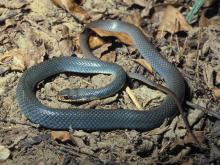
Species Types
Scientific Name
Coluber constrictor flaviventris (eastern yellow-bellied racer) and Coluber constrictor priapus (southern black racer)
Description
The eastern yellow-bellied racer is uniformly tan, brown, olive, blue, gray, or nearly black on top, with a yellow, cream, or light blue-gray belly. It occurs nearly statewide. The southern black racer subspecies also lives in the southeastern half of the state.
Media

Species Types
Scientific Name
Thamnophis proximus proximus
Description
The orange-striped ribbonsnake is a type of gartersnake named for the attractive orange or yellow stripes running the length of its body, alternating with wide black stripes. It is found statewide, but seldom far from water.
Media
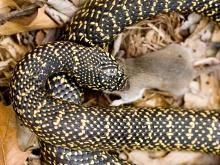
Species Types
Scientific Name
Lampropeltis holbrooki
Description
The speckled kingsnake is generally black, but a white or yellow spot in the center of most of the scales makes it look speckled. The belly is yellowish with some irregular black markings. A harmless, beneficial snake found nearly statewide.
Media
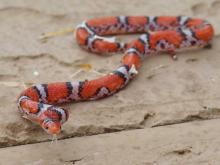
Species Types
Scientific Name
Cemophora coccinea copei
Description
One of Missouri's most brilliantly colored snakes is also extremely rare to find. The northern scarletsnake is similar in pattern and color to the more common red milksnake but has a red or orange snout and a spotless, white belly.
Media
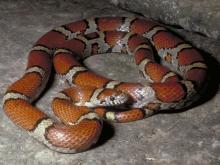
Species Types
Scientific Name
Lampropeltis triangulum
Description
The harmless eastern milksnake is white, yellow, or light tan, with red or orange blotches bordered with black. The belly is white and strongly checked with black. This species often is misidentified as the venomous coralsnake, which is not found in Missouri.
Media
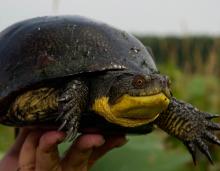
Species Types
Scientific Name
Emydoidea blandingii
Description
Blanding’s turtle has an oval, moderately high-domed upper shell and a long head and neck. This turtle is endangered in Missouri and occurs only in the extreme northern corners of the state.
Media
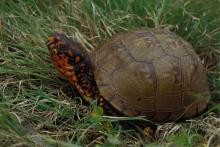
Species Types
Scientific Name
Terrapene carolina triunguis
Description
The three-toed box turtle usually has three hind toes. Its high-domed shell usually has a top ridge and is olive or brown with faint yellow or orange lines. Look for it in woodland habitats.
Media
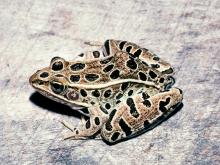
Species Types
Scientific Name
Lithobates pipiens
Description
The northern leopard frog is a medium-sized frog with dark spots on the back. Two skin folds run down each side of the back. In Missouri, it only occurs in a few northwestern counties along the Iowa border.
See Also
About Reptiles and Amphibians in Missouri
Missouri’s herptiles comprise 43 amphibians and 75 reptiles. Amphibians, including salamanders, toads, and frogs, are vertebrate animals that spend at least part of their life cycle in water. They usually have moist skin, lack scales or claws, and are ectothermal (cold-blooded), so they do not produce their own body heat the way birds and mammals do. Reptiles, including turtles, lizards, and snakes, are also vertebrates, and most are ectothermal, but unlike amphibians, reptiles have dry skin with scales, the ones with legs have claws, and they do not have to live part of their lives in water.





















